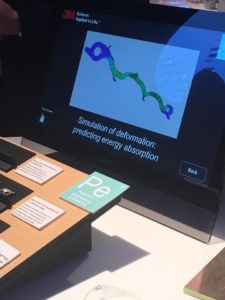By Karen L. Edwards.
METALCON 2019 took place in Steel City – Pittsburgh, Pennsylvania and RT3 members were well represented at the show, exhibiting and speaking. On the first day of the show, RT3 hosted a discussion on the importance of artificial intelligence and utilizing data for contractors.
Bill Wilkins of Pointivo spoke about AI and explained that there are a number of companies that offer AI-assisted approaches to roof evaluations. His company has been working with another RT3 member to develop a system that will do just that. Bill explained asking a person to try to look at an image and identify drains, equipment, ponding water, areas of membrane splits, etc. can be a very time-consuming process. Ai is a great opportunity to help augment a younger , more inexperienced work force in identifying rooftop conditions and problem areas.
AI can tell you what it thinks is on the roof and provide a confidence level in its identification. How you help is by looking at what it found and either confirming it or correcting it. Each time you provide confirmation or correction, it will learn from the information and keep getting better at what it does. Bill explained that they feel pretty confident that the tool they are introducing next year will be able to reduce the amount of time spent on evaluations by 80 percent through the use of drones and AI.
Key things for AI to be successful is quality data, quantity of data. Bill shared the example of teaching AI to recognize on AC unit on a roof. Because an AC unit is so large, it might only need to ‘see’ 100 images to be able to accurately identify the AC unit every time. Trying to identify hail damage will be harder, because it’s much smaller in size. The more data, imagery and confirmations it receives, the smarter and faster it becomes.
Josey Parks of Cognitive Contractor shared how AI and data can be a powerful lead and sales tool for roofing businesses. Josey explained that if you take the records for 1,000 customers and run them through an AI program it will learn from the data. It will recognize patterns of the first 70 percent (or 700 records). Then it will take the next 300 records and predict their behavior based on what it learned from the first 700 and provide them a score. Contractors should understand the data that they have in their business and how they can structure it to understand what drives your business and your customers.
Josey explained how when he started in metal roofing, he would keep track on a paper of what neighborhoods he had knocked doors in, then he advanced to using a bike trail app to track the locations where he and his sales team had been. They have advanced today to sending emails and plotting on a map (like Google Earth) the locations of the people who opened the email. This allows the canvassers to have an optimized route to work from.
Taking it one step further with the advancement in technology, Josey explained that he is able to use AI to score and predict his leads to the point that it knows which salesperson is the best one to assign that lead to, based on past performance of the sales person. It’s important to optimize your business and not waste time and resources assigning the wrong leads to the wrong salesperson.
If you missed their talk at METALCON, you can watch it on our Facebook page under Videos. Be sure to sign up for the Smart Brief e-newsletter to get the latest roofing tech news in your inbox.

